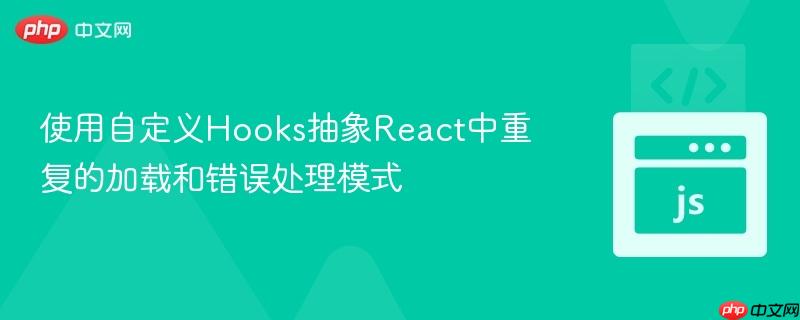
本文旨在探讨并解决react应用中常见的重复性代码模式,特别是针对异步操作的加载状态和错误处理逻辑。通过引入自定义hooks,我们可以有效地抽象这些通用逻辑,显著减少代码冗余,提升组件的可读性、可维护性及复用性,从而构建更清晰、更专业的react应用架构。
在构建复杂的React应用程序时,开发者经常会遇到需要管理异步操作状态的场景,例如数据加载、表单提交或搜索功能。这些操作通常伴随着加载指示器、错误消息显示以及错误消息的自动清除等逻辑。当这些模式在多个组件或同一组件内不同功能中重复出现时,会导致代码冗余、难以维护,并降低开发效率。
让我们观察一个典型的重复模式,它通常包含以下几个核心要素:
在实际开发中,这些模式会针对不同的业务逻辑(如加载供应商、加载制造商、搜索部件)被复制粘贴,仅改变变量前缀,如下图所示:
// 加载所有供应商
const [loadingAllVendors, setLoadingAllVendors] = useState<boolean>(true);
const loadAllVendorsErrorTimeout = useRef<NodeJS.Timeout|null>(null);
const [loadAllVendorsError, setLoadAllVendorsError] = useState<string|null>(null);
const handleLoadAllVendorsError = (error: string|null) => { /* ... */ };
const loadAllVendorsErrorTime: number = 6;
const timedLoadAllVendorsError = useCallback((error: string, seconds: number) => { /* ... */ }, []);
// 加载所有制造商
const [loadingAllManufacturers, setLoadingAllManufacturers] = useState<boolean>(true);
const loadAllManufacturersErrorTimeout = useRef<NodeJS.Timeout|null>(null);
const [loadAllManufacturersError, setLoadAllManufacturersError] = useState<string|null>(null);
const handleLoadAllManufacturersError = (error: string|null) => { /* ... */ };
const loadAllManufacturersErrorTime: number = 6;
const timedLoadAllManufacturersError = useCallback((error: string, seconds: number) => { /* ... */ }, []);
// 搜索部件
const [searching, setSearching] = useState<boolean>(false);
const searchErrorTimeout = useRef<NodeJS.Timeout|null>(null);
const [searchError, setSearchError] = useState<string|null>(null);
const handleSearchError = (error: string|null) => { /* ... */ };
const searchErrorTime: number = 6;
const timedSearchError = useCallback((error: string, seconds: number) => { /* ... */ }, []);这种重复的代码结构正是自定义Hooks的用武之地。
自定义Hooks是React提供的一种强大的机制,允许我们将组件逻辑(如状态管理和副作用)封装起来并在多个组件之间共享。通过创建一个自定义Hook,我们可以将上述重复的加载和错误处理逻辑抽象为一个可重用的单元。
我们的自定义Hook需要实现以下功能:
我们将这个Hook命名为 useAsyncOperationState。
import { useState, useRef, useCallback, useEffect } from 'react';
interface AsyncOperationState {
isLoading: boolean;
error: string | null;
setIsLoading: (loading: boolean) => void;
handleError: (error: string | null) => void;
setErrorWithTimeout: (error: string, seconds?: number) => void;
clearError: () => void;
}
/**
* 抽象异步操作的加载状态和错误处理逻辑。
* @param initialLoadingState 初始加载状态,默认为 false。
* @param defaultErrorDisplaySeconds 错误消息默认显示时长,默认为 5 秒。
* @returns 包含加载状态、错误信息及相关操作函数的对象。
*/
export function useAsyncOperationState(
initialLoadingState: boolean = false,
defaultErrorDisplaySeconds: number = 5
): AsyncOperationState {
const [isLoading, setIsLoading] = useState<boolean>(initialLoadingState);
const [error, setError] = useState<string | null>(null);
const errorTimeoutRef = useRef<NodeJS.Timeout | null>(null);
// 清除错误消息
const clearError = useCallback(() => {
setError(null);
if (errorTimeoutRef.current) {
clearTimeout(errorTimeoutRef.current);
errorTimeoutRef.current = null;
}
}, []);
// 处理错误:设置错误消息并可选地记录
const handleError = useCallback((err: string | null) => {
if (err) {
console.error("Operation Error:", err); // 可以在此处集成日志服务
setError(err);
} else {
clearError();
}
}, [clearError]);
// 设置错误消息并在指定时间后自动清除
const setErrorWithTimeout = useCallback((
err: string,
seconds: number = defaultErrorDisplaySeconds
) => {
handleError(err); // 先设置错误消息
if (errorTimeoutRef.current) {
clearTimeout(errorTimeoutRef.current); // 清除之前的定时器
}
errorTimeoutRef.current = setTimeout(() => {
clearError(); // 指定时间后清除错误
}, seconds * 1000);
}, [handleError, clearError, defaultErrorDisplaySeconds]);
// 组件卸载时清除任何待处理的定时器
useEffect(() => {
return () => {
if (errorTimeoutRef.current) {
clearTimeout(errorTimeoutRef.current);
}
};
}, []);
return {
isLoading,
error,
setIsLoading,
handleError,
setErrorWithTimeout,
clearError,
};
}Hook实现详解:
现在,我们可以用 useAsyncOperationState Hook 来替换组件中那些重复的逻辑。
import React from 'react';
import { useAsyncOperationState } from './useAsyncOperationState'; // 假设Hook文件路径
function MyComponent() {
// 针对加载所有供应商
const {
isLoading: loadingAllVendors,
error: loadAllVendorsError,
setIsLoading: setLoadingAllVendors,
setErrorWithTimeout: setTimedLoadAllVendorsError,
handleError: handleLoadAllVendorsError // 如果需要即时设置错误且不带定时器
} = useAsyncOperationState(true, 6); // 初始加载状态为true,默认错误显示6秒
// 针对加载所有制造商
const {
isLoading: loadingAllManufacturers,
error: loadAllManufacturersError,
setIsLoading: setLoadingAllManufacturers,
setErrorWithTimeout: setTimedLoadAllManufacturersError,
handleError: handleLoadAllManufacturersError
} = useAsyncOperationState(true, 6); // 初始加载状态为true,默认错误显示6秒
// 针对搜索部件
const {
isLoading: searching,
error: searchError,
setIsLoading: setSearching,
setErrorWithTimeout: setTimedSearchError,
handleError: handleSearchError
} = useAsyncOperationState(false, 6); // 初始加载状态为false,默认错误显示6秒
// 模拟异步操作
const fetchData = async (operationType: string) => {
let setIsLoading, setTimedError;
switch (operationType) {
case 'vendors':
setIsLoading = setLoadingAllVendors;
setTimedError = setTimedLoadAllVendorsError;
break;
case 'manufacturers':
setIsLoading = setLoadingAllManufacturers;
setTimedError = setTimedLoadAllManufacturersError;
break;
case 'search':
setIsLoading = setSearching;
setTimedError = setTimedSearchError;
break;
default:
return;
}
setIsLoading(true);
try {
// 模拟网络请求
await new Promise(resolve => setTimeout(resolve, 1500));
if (Math.random() > 0.7) { // 模拟请求失败
throw new Error(`Failed to load ${operationType}`);
}
console.log(`${operationType} loaded successfully.`);
} catch (err: any) {
setTimedError(err.message, 10); // 错误消息显示10秒
} finally {
setIsLoading(false);
}
};
return (
<div>
<h1>异步操作状态管理</h1>
<section>
<h2>供应商数据</h2>
{loadingAllVendors && <p>正在加载供应商...</p>}
{loadAllVendorsError && <p style={{ color: 'red' }}>错误: {loadAllVendorsError}</p>}
<button onClick={() => fetchData('vendors')} disabled={loadingAllVendors}>
{loadingAllVendors ? '加载中...' : '加载供应商'}
</button>
</section>
<section>
<h2>制造商数据</h2>
{loadingAllManufacturers && <p>正在加载制造商...</p>}
{loadAllManufacturersError && <p style={{ color: 'red' }}>错误: {loadAllManufacturersError}</p>}
<button onClick={() => fetchData('manufacturers')} disabled={loadingAllManufacturers}>
{loadingAllManufacturers ? '加载中...' : '加载制造商'}
</button>
</section>
<section>
<h2>搜索部件</h2>
{searching && <p>正在搜索...</p>}
{searchError && <p style={{ color: 'red' }}>错误: {searchError}</p>}
<button onClick={() => fetchData('search')} disabled={searching}>
{searching ? '搜索中...' : '搜索部件'}
</button>
</section>
</div>
);
}
export default MyComponent;通过上述示例,可以看到组件内部的代码变得更加简洁和专注于业务逻辑。每个异步操作都通过调用 useAsyncOperationState Hook 来获取其独立的加载和错误管理能力。
自定义Hooks是React中解决代码复用和逻辑抽象问题的强大工具。通过将常见的异步操作状态管理模式封装到 useAsyncOperationState 这样的Hook中,我们不仅减少了代码冗余,还显著提升了React应用程序的模块化、可读性和可维护性。这使得开发者能够构建更健壮、更专业的React应用,同时保持代码库的整洁和高效。
以上就是使用自定义Hooks抽象React中重复的加载和错误处理模式的详细内容,更多请关注php中文网其它相关文章!

每个人都需要一台速度更快、更稳定的 PC。随着时间的推移,垃圾文件、旧注册表数据和不必要的后台进程会占用资源并降低性能。幸运的是,许多工具可以让 Windows 保持平稳运行。

Copyright 2014-2025 https://www.php.cn/ All Rights Reserved | php.cn | 湘ICP备2023035733号